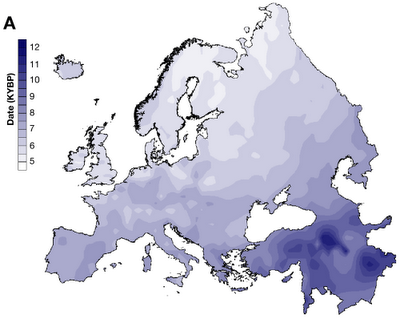Over at my other blog I have a review up of a new paper in PLoS Biology. The authors argue that a particular Y haplogroup lineage, R1b1b2, which has often been assumed to be a marker of indigenous Paleolithic Europeans (i.e., those who were extant before the rise of agriculture and the spread of farmers), is actually a signature of Anatolians who brough agriculture. This probably isn’t too surprising for the genetic genealogy nuts among the readers. After I got a copy of this paper I poked around the internet and the general finding that R1b1b2 was very diverse in the eastern Mediterranean seems to have been well known among the genetic genealogy community (also see Anatole Klyosov’s paper and what he says about Basques specifically). And then in eastern Europe you have R1a1, which seems to have also undergone recent range expansion. Finally, there are the recent rumblings out of ancient DNA extraction which imply a lot of turnover of mtDNA lineages during the shift from hunter-gathering to agriculture.
 I think this makes us reconsider the idea that most of the ancestors of contemporary citizens of the European Union who were alive 10,000 years ago were actually resident within the current borders of the European Union. But let’s put the details of that aside for a moment. Which group might be most representative of Paleolithic Europeans? If the paper above is correct, the Basques are not a good proxy for the ancient hunter-gatherers of Europe.
I think this makes us reconsider the idea that most of the ancestors of contemporary citizens of the European Union who were alive 10,000 years ago were actually resident within the current borders of the European Union. But let’s put the details of that aside for a moment. Which group might be most representative of Paleolithic Europeans? If the paper above is correct, the Basques are not a good proxy for the ancient hunter-gatherers of Europe.
Let’s look at a map which illustrates the spread of agriculture. I’d always focused on the SE-NW cline, but if the U5 mtDNA haplogroup is a reasonable marker of ancient pre-agricultural Europeans, we need to look at the Finnic peoples of the northeast. This may explain why these populations also tend to be genetically distinct from other European groups; not because they’re an exotic admixture, but because they’re not. Anyway, simply speculation, I’m sure readers will have their opinions….